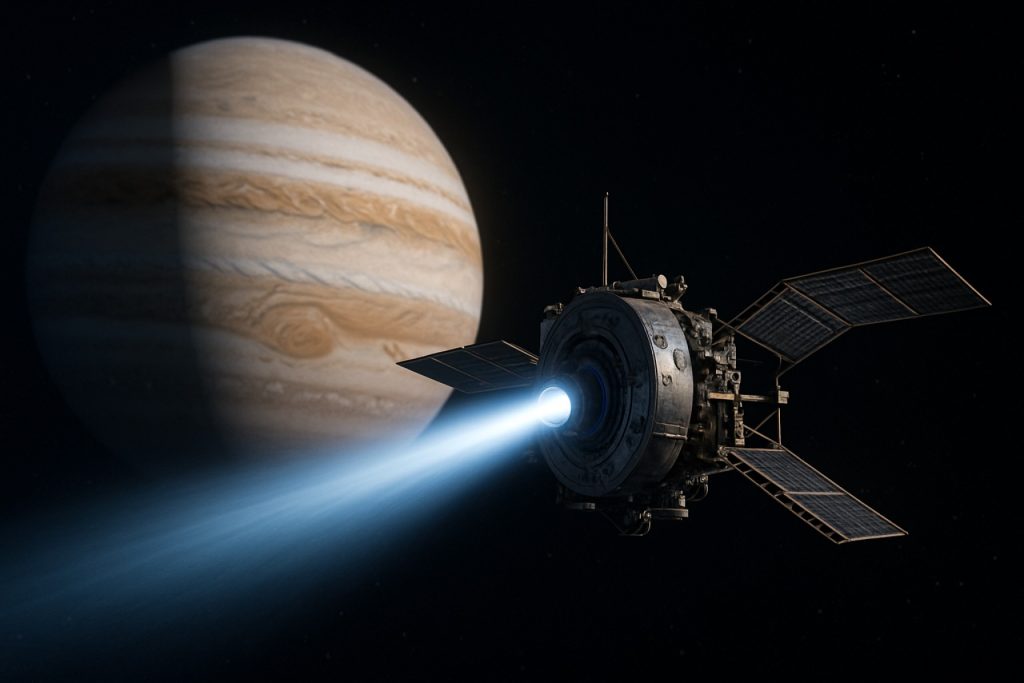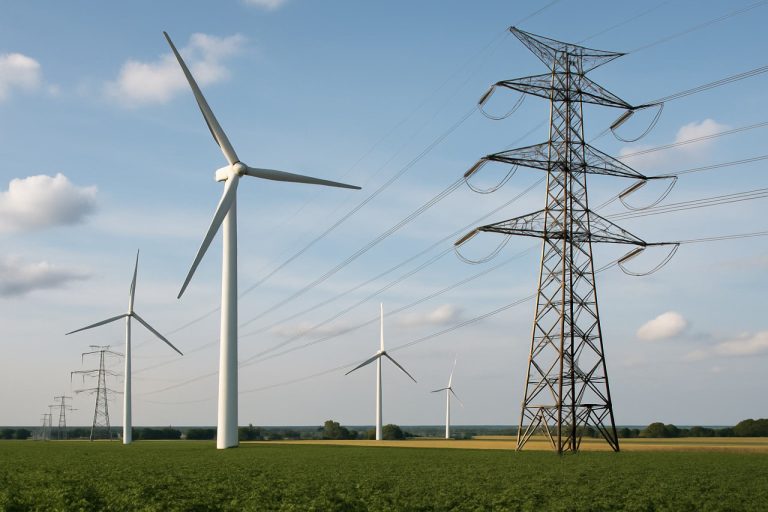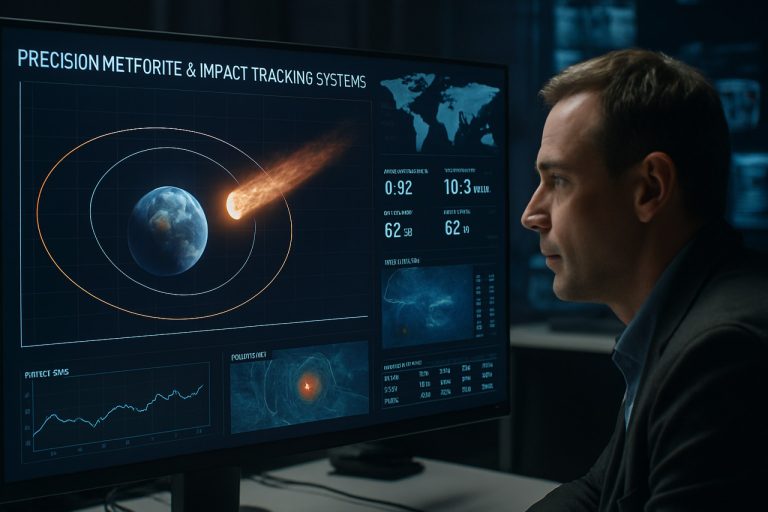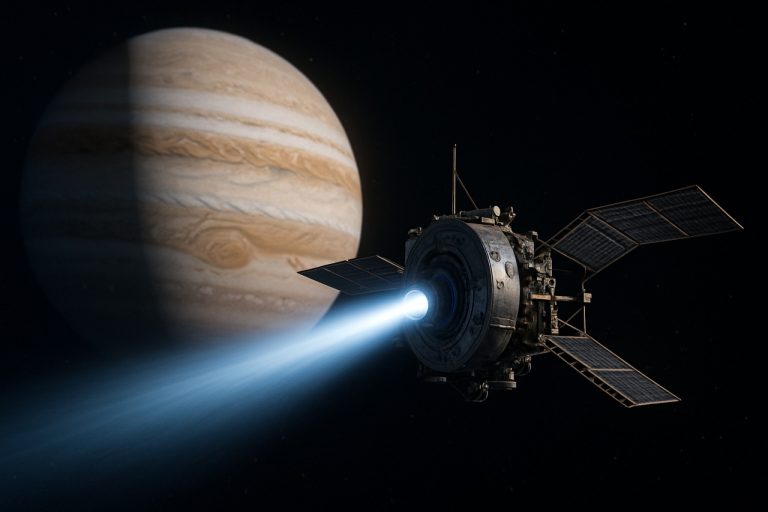
Electric Propulsion for Interplanetary Missions in 2025: How Next-Gen Thrusters Are Powering a New Era of Deep Space Exploration. Discover the Market Forces, Technology Shifts, and Strategic Opportunities Shaping the Next Five Years.
- Executive Summary: 2025 Outlook and Key Takeaways
- Market Size, Growth Rate, and Forecasts Through 2030
- Core Technologies: Hall Effect, Ion, and Advanced Electric Thrusters
- Major Players and Industry Initiatives (e.g., NASA, ESA, Aerojet Rocketdyne, Airbus)
- Recent Milestones and Demonstration Missions (2023–2025)
- Supply Chain, Manufacturing, and Integration Challenges
- Policy, Regulatory, and Funding Landscape
- Emerging Applications: Science, Cargo, and Crewed Missions
- Competitive Analysis and Strategic Partnerships
- Future Outlook: Innovation Roadmap and Market Opportunities (2025–2030)
- Sources & References
Executive Summary: 2025 Outlook and Key Takeaways
Electric propulsion (EP) technologies are poised to play a transformative role in interplanetary missions in 2025 and the immediate years ahead. As space agencies and private companies intensify their ambitions for Mars, the Moon, and beyond, EP systems—particularly Hall-effect thrusters, ion engines, and advanced gridded ion thrusters—are increasingly favored for their high efficiency and significant propellant savings compared to traditional chemical propulsion.
In 2025, several high-profile missions are set to leverage electric propulsion. The European Space Agency’s (ESA) ESA BepiColombo mission, already en route to Mercury, continues to demonstrate the long-duration capabilities of solar electric propulsion (SEP) in deep space. Meanwhile, NASA’s NASA Psyche mission, launched in late 2023, is using Hall-effect thrusters supplied by Maxar Technologies—a major provider of EP systems for both government and commercial spacecraft. These missions are providing critical data on the reliability and performance of EP in the harsh interplanetary environment.
Commercial momentum is also accelerating. Aerojet Rocketdyne (now part of L3Harris) and Aerospace Corporation are advancing next-generation ion and Hall thruster designs, targeting higher power levels and longer operational lifetimes. Thales Group and Airbus are expanding their EP portfolios, with Airbus’s E3000 platform supporting both commercial and scientific missions. These companies are investing in scaling up thruster power (10 kW and above) to enable faster transit times and heavier payloads for Mars and asteroid missions.
Key takeaways for 2025 include:
- Electric propulsion is now a baseline technology for deep space missions, with multiple operational spacecraft providing real-world validation.
- Major industry players—Maxar Technologies, Aerojet Rocketdyne, Thales Group, and Airbus—are scaling up R&D and production to meet growing demand for interplanetary-capable EP systems.
- Ongoing and upcoming missions in 2025 will further refine EP’s operational envelope, especially regarding high-power, long-duration performance and system integration with large solar arrays or future nuclear power sources.
- EP’s efficiency and scalability are critical enablers for ambitious exploration goals, including Mars cargo delivery, asteroid rendezvous, and lunar logistics.
Looking ahead, the next few years will see electric propulsion systems become even more central to interplanetary mission architectures, with continued advancements in power, reliability, and mission flexibility expected from both established aerospace leaders and emerging technology providers.
Market Size, Growth Rate, and Forecasts Through 2030
The market for electric propulsion systems in interplanetary missions is poised for significant growth through 2030, driven by increasing demand for efficient, high-performance propulsion technologies in both governmental and commercial deep space exploration programs. As of 2025, the sector is characterized by a surge in investments and mission planning, with several flagship projects leveraging electric propulsion for journeys beyond Earth orbit.
Key industry players such as Airbus, Northrop Grumman, and ArianeGroup are actively developing and supplying advanced electric propulsion systems, including Hall-effect thrusters and ion engines, for upcoming interplanetary spacecraft. NASA and ESA continue to be major institutional customers, with missions like NASA’s Psyche (launched in 2023) and ESA’s BepiColombo (en route to Mercury) demonstrating the operational maturity of solar electric propulsion in deep space.
The market size for electric propulsion in interplanetary missions is estimated to be in the low hundreds of millions of USD in 2025, with projections indicating a compound annual growth rate (CAGR) exceeding 10% through 2030. This growth is underpinned by the expanding pipeline of interplanetary missions, including NASA’s planned Mars Sample Return, ESA’s Hera mission, and commercial lunar and asteroid exploration initiatives. The increasing adoption of electric propulsion is attributed to its high specific impulse and propellant efficiency, which are critical for reducing mission mass and enabling complex trajectories over long distances.
Commercial suppliers such as Thales and OHB SE are scaling up production capabilities to meet anticipated demand, while new entrants and startups are innovating in high-power electric propulsion and next-generation thruster technologies. The market outlook is further bolstered by government funding and international collaborations, as agencies prioritize sustainable and cost-effective propulsion solutions for ambitious exploration goals.
Looking ahead to 2030, the electric propulsion market for interplanetary missions is expected to benefit from the maturation of megawatt-class systems, the integration of nuclear-electric propulsion concepts, and the growing participation of private sector actors. As mission architectures evolve to support human exploration of Mars and beyond, electric propulsion is set to become a cornerstone technology, driving robust market expansion and technological advancement in the coming years.
Core Technologies: Hall Effect, Ion, and Advanced Electric Thrusters
Electric propulsion (EP) technologies, particularly Hall Effect thrusters, ion engines, and advanced variants, are at the forefront of enabling efficient interplanetary missions in 2025 and the coming years. These systems offer significant advantages over traditional chemical propulsion, including higher specific impulse, reduced propellant mass, and the ability to perform long-duration, deep-space maneuvers.
Hall Effect Thrusters have become the workhorse for many current and planned interplanetary missions. These devices use a magnetic field to ionize and accelerate propellant, typically xenon, achieving specific impulses in the range of 1,500–2,500 seconds. ArianeGroup and Safran are among the European leaders, with their PPS® series thrusters already flight-proven on missions such as ESA’s BepiColombo. In the United States, Northrop Grumman and Aerojet Rocketdyne continue to advance Hall thruster technology, with Northrop Grumman’s XR-5 and Aerojet Rocketdyne’s development of higher-power systems for NASA’s Gateway and future Mars missions.
Ion Thrusters offer even higher specific impulses (up to 4,000 seconds or more), making them ideal for deep-space science missions. NASA’s NEXT-C ion engine, developed in partnership with Aerojet Rocketdyne, is scheduled for use on the upcoming Europa Clipper mission, launching in 2025. This engine builds on the legacy of the NSTAR thruster, which powered the successful Dawn and Deep Space 1 missions. In Europe, Airbus continues to refine its T6 ion thruster, which is already operational on the BepiColombo spacecraft en route to Mercury.
Advanced Electric Thrusters are also progressing rapidly. Magnetoplasmadynamic (MPD) thrusters and gridded ion engines with advanced cathode and grid materials are under active development. NASA is investing in high-power EP systems (up to 50 kW and beyond) for future Mars cargo and crewed missions, with technology demonstrations expected before 2030. Thales and Safran are collaborating on next-generation thrusters for both commercial and exploration applications, focusing on higher efficiency and longer operational lifetimes.
Looking ahead, the integration of electric propulsion with solar electric power and, eventually, nuclear electric power is expected to further expand mission capabilities. The next few years will see the deployment of more powerful and efficient EP systems on both robotic and, eventually, human interplanetary missions, solidifying electric propulsion as a core technology for deep-space exploration.
Major Players and Industry Initiatives (e.g., NASA, ESA, Aerojet Rocketdyne, Airbus)
The landscape of electric propulsion for interplanetary missions in 2025 is shaped by a combination of established aerospace agencies, major propulsion manufacturers, and emerging private sector initiatives. These players are driving advancements in ion, Hall-effect, and other electric propulsion technologies, aiming to enable more efficient and ambitious missions beyond Earth orbit.
Among government agencies, NASA remains a global leader. Its ongoing work with Solar Electric Propulsion (SEP) is central to the Artemis program’s lunar Gateway and future Mars missions. NASA’s Advanced Electric Propulsion System (AEPS), developed in partnership with Aerojet Rocketdyne, is scheduled for integration into the Power and Propulsion Element (PPE) of the Gateway, with launch targeted for the late 2020s. The AEPS Hall-effect thrusters are designed to deliver up to 12.5 kW each, representing a significant leap in power and efficiency for deep space operations.
In Europe, the European Space Agency (ESA) continues to invest in electric propulsion for both science and exploration missions. ESA’s BepiColombo mission to Mercury, launched in 2018, is currently the most powerful interplanetary electric propulsion spacecraft in operation, utilizing four QinetiQ T6 ion thrusters. Building on this heritage, ESA is supporting the development of next-generation thrusters for future missions, including the Hera asteroid mission and potential Mars sample return efforts.
On the commercial side, Airbus is a major supplier of electric propulsion systems, notably its Eurostar E3000 platform, which has flown on numerous telecommunications satellites and is being adapted for interplanetary applications. Airbus is also involved in ESA’s Hera mission, providing propulsion and spacecraft integration expertise.
Other significant contributors include Thales, which manufactures the PPS® Hall-effect thruster family, and SITAEL, an Italian company specializing in advanced electric propulsion for both commercial and scientific spacecraft. SITAEL’s HT100 and HT400 thrusters are being considered for upcoming European and international missions.
Looking ahead, the next few years will see the deployment of higher-power electric propulsion systems, with a focus on scalability and reliability for long-duration missions. The collaboration between agencies and industry is expected to accelerate, with demonstration flights and technology maturation paving the way for human and robotic exploration of Mars and beyond.
Recent Milestones and Demonstration Missions (2023–2025)
Between 2023 and 2025, electric propulsion (EP) systems have achieved significant milestones in interplanetary missions, marking a transition from experimental technology to operational mainstay for deep space exploration. The period has seen both government agencies and private industry demonstrate the reliability, efficiency, and scalability of EP for missions beyond Earth orbit.
A landmark event was the launch and ongoing operation of NASA’s Europa Clipper mission, which utilizes a large-scale solar electric propulsion (SEP) system. Launched in October 2024, Europa Clipper is equipped with Hall-effect thrusters developed by Aerojet Rocketdyne, providing the high-efficiency, long-duration thrust required for its complex trajectory to Jupiter’s moon Europa. This mission represents the largest SEP system ever flown for a planetary science mission, with its performance closely watched as a benchmark for future deep space applications.
In parallel, the European Space Agency (ESA) has advanced its own electric propulsion capabilities. The BepiColombo mission, a joint ESA-JAXA project en route to Mercury, continues to demonstrate the endurance of gridded ion thrusters supplied by Airbus. Since its launch in 2018, BepiColombo’s EP system has completed multiple deep-space maneuvers, and by 2025, it will have executed the majority of its interplanetary cruise using electric propulsion, validating the technology for long-duration, high delta-V missions.
Commercial players have also made notable progress. Maxar Technologies has supplied high-power Hall thrusters for NASA’s Psyche mission, which launched in October 2023. The mission’s successful operation of EP in the harsh environment of deep space is providing valuable data on system longevity and performance, informing the design of next-generation commercial and government spacecraft.
Looking ahead, the Gateway lunar outpost, a cornerstone of NASA’s Artemis program, is scheduled to begin deployment in the mid-2020s. Its Power and Propulsion Element (PPE), built by Maxar Technologies, will feature the most powerful Hall-effect thrusters ever flown, further cementing EP’s role in sustained lunar and interplanetary operations.
These milestones collectively demonstrate that, as of 2025, electric propulsion is no longer a niche technology but a critical enabler for ambitious interplanetary missions. The successful operation of EP systems by leading organizations such as NASA, ESA, Aerojet Rocketdyne, Airbus, and Maxar Technologies is setting the stage for even more advanced missions in the coming years.
Supply Chain, Manufacturing, and Integration Challenges
The supply chain, manufacturing, and integration of electric propulsion (EP) systems for interplanetary missions are entering a critical phase in 2025, as demand accelerates for high-performance, reliable, and scalable solutions. The sector is characterized by a small number of specialized suppliers, complex qualification requirements, and the need for robust integration with spacecraft platforms designed for deep space environments.
Key manufacturers such as Aerojet Rocketdyne, Thales Group, and Airbus are leading the development and production of Hall-effect thrusters, ion engines, and gridded ion propulsion systems. These companies have established vertically integrated supply chains, but still face challenges in sourcing high-purity xenon propellant, rare earth magnets, and custom power processing units. For example, Aerojet Rocketdyne continues to scale up production of its NEXT-C ion thruster, which is slated for use on NASA’s upcoming interplanetary missions, but must coordinate with specialty suppliers for critical components such as discharge chambers and cathodes.
The supply chain is further complicated by the need for rigorous testing and qualification. EP systems must demonstrate long-duration reliability, often exceeding 10,000 hours of operation, and must be integrated with spacecraft avionics, thermal management, and power systems. This requires close collaboration between propulsion manufacturers and spacecraft integrators such as Lockheed Martin and Boeing, who are responsible for end-to-end mission assurance. In 2025, these integrators are working to streamline the interface between EP modules and next-generation spacecraft buses, with a focus on modularity and rapid reconfiguration for diverse mission profiles.
A significant bottleneck remains in the production of high-purity xenon, the preferred propellant for most EP systems. Suppliers such as Air Liquide are investing in expanded capacity, but the global market for xenon is tight, with prices remaining volatile due to competing demand from the semiconductor industry. This has prompted research into alternative propellants and recycling technologies, but widespread adoption is not expected before the late 2020s.
Looking ahead, the outlook for EP supply chains in 2025 and the following years is cautiously optimistic. Major players are investing in automation and digital manufacturing to reduce lead times and costs. However, the sector remains vulnerable to single-source dependencies and geopolitical risks affecting rare materials. Continued collaboration between propulsion developers, spacecraft integrators, and material suppliers will be essential to meet the ambitious timelines of upcoming interplanetary missions.
Policy, Regulatory, and Funding Landscape
The policy, regulatory, and funding landscape for electric propulsion (EP) in interplanetary missions is rapidly evolving as government agencies and industry leaders prioritize advanced propulsion technologies for deep space exploration. In 2025, the United States, European Union, and other spacefaring nations are actively shaping frameworks and allocating resources to accelerate the adoption of EP systems, particularly for missions beyond Earth orbit.
In the United States, NASA continues to be the primary driver of EP development for interplanetary missions. The agency’s ongoing support is evident in its funding of the Solar Electric Propulsion (SEP) program, which underpins the NASA Psyche mission (launched in 2023) and the planned use of EP for the upcoming Gateway lunar outpost. The 2025 NASA budget proposal maintains robust investment in advanced propulsion, with a focus on Hall-effect thrusters and next-generation ion engines. These efforts are supported by the U.S. Department of Energy, which collaborates on power systems for high-power EP, and by regulatory oversight from the Federal Aviation Administration (FAA) for launch and in-space operations.
In Europe, the European Space Agency (ESA) is advancing EP through its ARTES and HERA programs, with funding allocated for both technology maturation and demonstration missions. ESA’s regulatory environment is shaped by the European Commission’s space policy, which emphasizes sustainability and international collaboration. The agency is also working with member states to harmonize standards for EP system qualification and in-space safety.
Private sector involvement is increasing, with companies such as Airbus and Thales in Europe, and Northrop Grumman and Aerojet Rocketdyne in the U.S., receiving government contracts and direct funding for EP system development. These companies are also engaging with export control regulations, such as ITAR in the U.S. and the EU Dual-Use Regulation, which impact the international transfer of EP technologies.
Looking ahead, the policy landscape is expected to further incentivize public-private partnerships and international cooperation, particularly as agencies prepare for Mars sample return and crewed Mars missions in the 2030s. Funding is likely to remain strong, with new calls for proposals and technology demonstration missions anticipated in the next few years. Regulatory bodies are also expected to update guidelines to address the unique challenges of high-power EP systems, including space traffic management and debris mitigation.
Emerging Applications: Science, Cargo, and Crewed Missions
Electric propulsion (EP) is rapidly transitioning from a technology primarily used for satellite station-keeping to a cornerstone of interplanetary mission design. As of 2025, the adoption of EP systems—especially Hall-effect thrusters and ion engines—is accelerating for science, cargo, and, prospectively, crewed missions beyond Earth orbit.
For science missions, EP is already enabling ambitious trajectories and extended mission lifetimes. The European Space Agency’s BepiColombo mission to Mercury, launched in 2018, continues to demonstrate the reliability of solar electric propulsion (SEP) in deep space, with its Airbus-built Mercury Transfer Module using four QinetiQ T6 ion thrusters. This success has influenced the design of upcoming missions, such as NASA’s Psyche, scheduled to arrive at its target in 2029, which utilizes a Hall-effect thruster system developed by Maxar Technologies for efficient cruise to the asteroid belt.
Cargo transport is another emerging application. NASA’s Artemis program is leveraging EP for the Gateway lunar outpost, with the Power and Propulsion Element (PPE) set to launch in the coming years. The PPE, built by Maxar Technologies, will use advanced Hall-effect thrusters to provide high-efficiency station-keeping and orbital transfer capabilities, marking the first use of large-scale EP for a human spaceflight support platform. This technology is expected to be a template for future Mars cargo missions, where mass efficiency is critical.
Looking ahead, the prospect of crewed interplanetary missions is driving investment in higher-power EP systems. NASA is actively developing the NextSTEP program, which includes public-private partnerships to mature megawatt-class EP for Mars transfer vehicles. Companies such as Northrop Grumman and Aerojet Rocketdyne are advancing high-thrust, high-efficiency EP concepts, with ground demonstrations expected by the late 2020s. These systems promise to reduce transit times and radiation exposure for astronauts, a key requirement for safe human exploration of Mars.
The outlook for EP in interplanetary missions over the next few years is robust. With ongoing flight heritage from science missions, imminent deployment for lunar cargo, and active development for crewed vehicles, electric propulsion is poised to become the backbone of sustainable deep space exploration. The continued collaboration between agencies and industry leaders such as Airbus, Maxar Technologies, and NASA will be instrumental in scaling EP capabilities for the next generation of interplanetary missions.
Competitive Analysis and Strategic Partnerships
The competitive landscape for electric propulsion (EP) systems in interplanetary missions is intensifying as both established aerospace primes and innovative startups accelerate development and deployment of advanced thrusters. As of 2025, the sector is characterized by a mix of government-backed programs, commercial satellite manufacturers, and propulsion specialists forming strategic alliances to address the demanding requirements of deep space travel.
Among the industry leaders, Airbus continues to advance its electric propulsion capabilities, leveraging its heritage in the Eurostar Neo platform and the EUTELSAT KONNECT VHTS satellite, which utilize all-electric propulsion for orbit raising and station-keeping. Airbus is actively collaborating with European space agencies and propulsion suppliers to adapt these technologies for interplanetary missions, focusing on higher-thrust Hall-effect and gridded ion thrusters.
In the United States, Northrop Grumman and Aerojet Rocketdyne (now part of L3Harris) are prominent players. Northrop Grumman’s experience with the Dawn mission’s ion propulsion and its ongoing work on NASA’s Gateway and lunar logistics projects position it as a key supplier for future Mars and asteroid missions. Aerojet Rocketdyne, with its NEXT-C ion thruster, is supplying propulsion for NASA’s upcoming NASA missions, including the Psyche spacecraft, and is developing higher-power systems for next-generation exploration.
Strategic partnerships are central to advancing EP for interplanetary use. Thales and Safran (through their joint venture Safran Space) are collaborating on the PPS®X00 Hall-effect thruster family, targeting both commercial and scientific deep space missions. These partnerships enable pooling of R&D resources and integration of propulsion with spacecraft platforms.
Emerging companies are also shaping the competitive field. Busek Co. Inc. is supplying Hall-effect and electrospray thrusters for NASA and commercial lunar landers, and is actively pursuing contracts for Mars transfer vehicles. ENEA (Italy’s National Agency for New Technologies, Energy and Sustainable Economic Development) is working with the European Space Agency on advanced ion propulsion demonstrators.
Looking ahead, the next few years will see increased cross-Atlantic collaboration, with European and US firms forming consortia to bid for flagship interplanetary missions. The push for higher power (20 kW+) EP systems, required for crewed Mars missions and large cargo transports, is driving joint ventures and technology sharing agreements. As government agencies set ambitious exploration goals, the competitive advantage will favor those companies able to demonstrate flight heritage, scalability, and integration with high-power solar arrays or nuclear power sources.
Future Outlook: Innovation Roadmap and Market Opportunities (2025–2030)
The period from 2025 onward is poised to be transformative for electric propulsion (EP) technologies in interplanetary missions, driven by both governmental and commercial initiatives. As the demand for efficient, high-delta-v propulsion grows—particularly for Mars, lunar, and deep-space exploration—electric propulsion systems are expected to play a central role in mission architectures.
Key players such as NASA and European Space Agency (ESA) are advancing the development and flight qualification of next-generation EP systems. NASA’s ongoing work on the Solar Electric Propulsion (SEP) system, notably for the upcoming Gateway lunar outpost and the Psyche mission, is setting benchmarks for high-power Hall-effect thrusters and gridded ion engines. The Gateway Power and Propulsion Element, scheduled for launch in the latter half of the 2020s, will demonstrate sustained operation of 50 kW-class Hall thrusters, a significant leap from the 4.5 kW-class systems used on previous missions (NASA).
In parallel, Airbus and Thales Group are scaling up their electric propulsion product lines, with a focus on higher-thrust, longer-life systems suitable for interplanetary transfer stages and cargo missions. Airbus’s E3000 platform, for example, is being adapted for deep-space applications, leveraging its heritage in geostationary satellite propulsion (Airbus). Thales is similarly investing in high-power Hall-effect thrusters, aiming to support both commercial and institutional exploration programs (Thales Group).
Commercial ventures are also accelerating innovation. Northrop Grumman and Aerojet Rocketdyne (now part of L3Harris) are developing advanced ion and Hall thrusters for NASA and commercial customers, targeting higher efficiency and longer operational lifetimes. These advancements are critical for enabling cost-effective, reusable interplanetary transport vehicles and logistics services.
Looking ahead to 2030, the market outlook for electric propulsion in interplanetary missions is robust. The maturation of megawatt-class solar arrays and power processing units will unlock new mission profiles, including crewed Mars transits and asteroid resource utilization. The integration of artificial intelligence for autonomous EP system management is expected to further enhance reliability and mission flexibility. As public-private partnerships proliferate, the sector anticipates a surge in demand for scalable, modular EP solutions, positioning electric propulsion as a cornerstone technology for the next era of solar system exploration.
Sources & References
- ESA
- NASA
- Maxar Technologies
- Thales Group
- Airbus
- Airbus
- Northrop Grumman
- NASA
- ESA
- Thales
- OHB SE
- SITAEL
- Lockheed Martin
- Boeing
- Air Liquide
- Maxar Technologies



